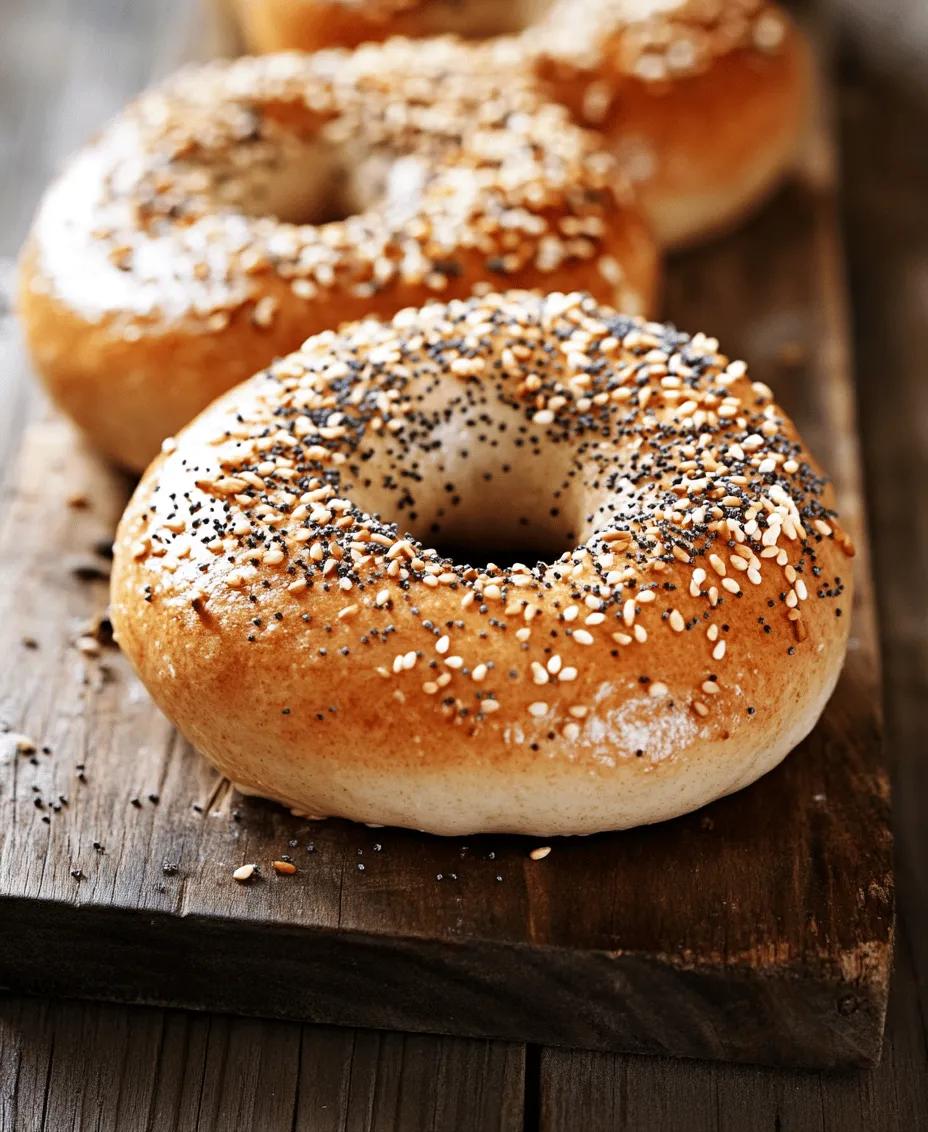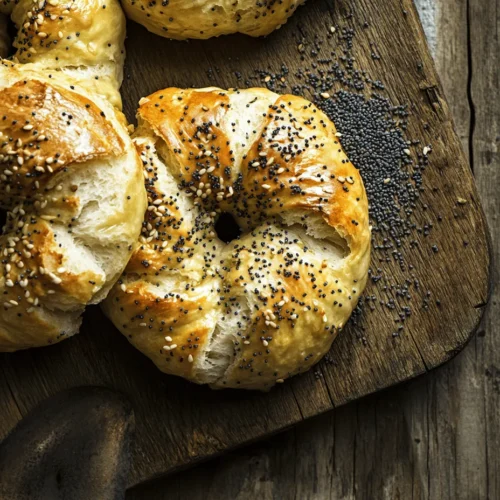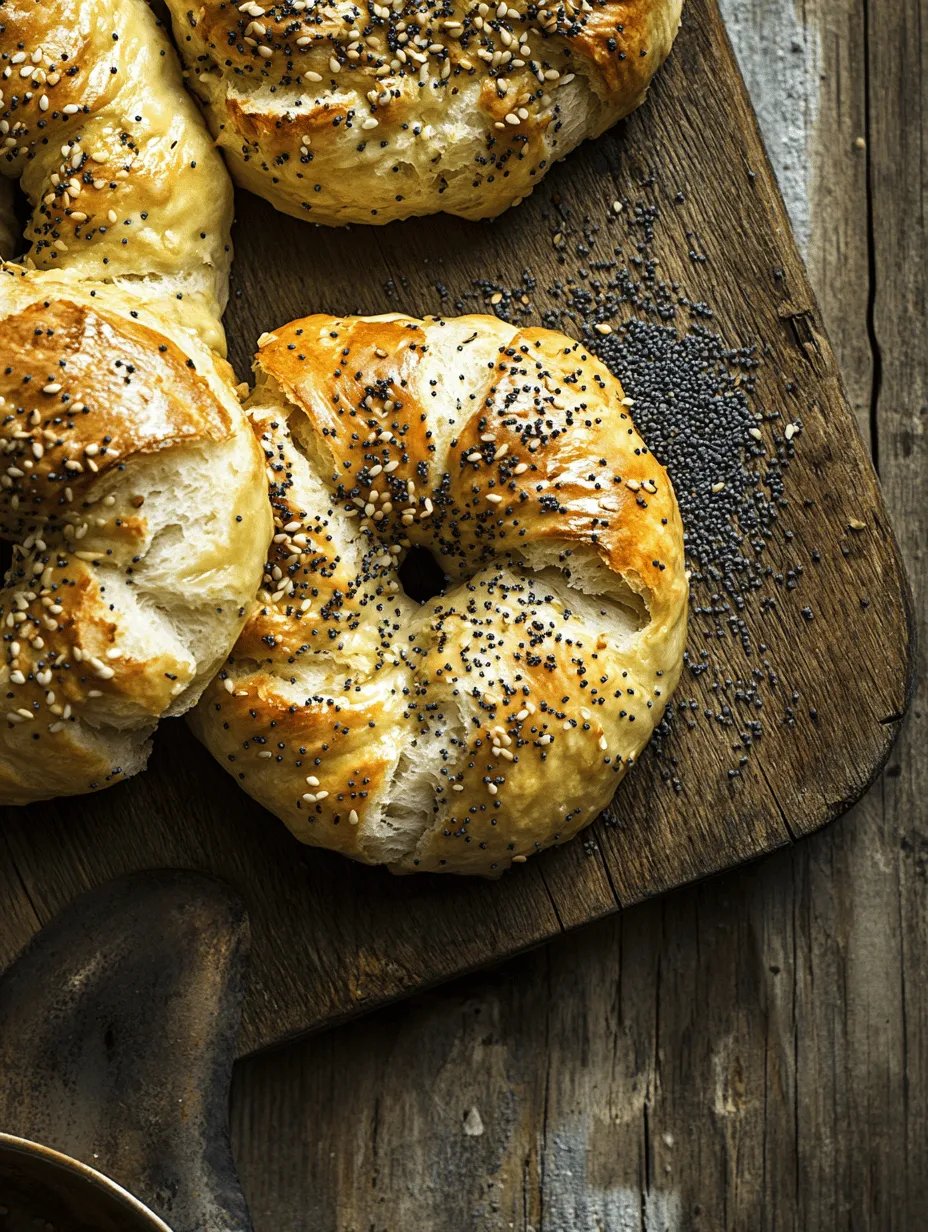Introduction
There’s something undeniably enchanting about the aroma of freshly baked bagels wafting through your kitchen. Homemade bagels have a certain magic that store-bought versions simply can’t replicate. The texture, the flavor, the satisfaction of creating something delicious from scratch—it’s an experience that many food enthusiasts treasure. Among the many varieties of bagels, Everything Bagels stand out as a crowd favorite. Their medley of toppings and delightful crunch make them the ideal companion for breakfast, lunch, or a snack any time of day.
What makes this Magic Everything Bagels recipe particularly appealing is its simplicity and quick preparation time. In just a short while, you can craft a batch of homemade bagels that are not only visually stunning but also bursting with flavor. One secret ingredient sets this recipe apart from the rest: Greek yogurt. This ingredient not only adds a subtle tang but also enhances the moisture and texture of the bagels, resulting in a light and chewy final product.
The Allure of Bagels
Bagels have a rich history that dates back centuries, with roots traceable to Eastern European Jewish communities. They originally emerged as a staple food in Poland and eventually made their way to the United States with immigrants in the late 19th century. Over the years, bagels have evolved into a beloved staple of American breakfast culture, celebrated for their versatility and unique texture—crispy on the outside and soft on the inside.
Among the many flavors available, Everything Bagels have captured the hearts—and taste buds—of many with their savory blend of toppings. Featuring a combination of sesame seeds, poppy seeds, onion flakes, garlic flakes, and salt, they offer a complex flavor profile that complements various spreads, from cream cheese to avocado. The rise of Everything Bagels can be attributed to their ability to provide a little bit of everything, making them an excellent choice for those who can’t decide on a single flavor.
There’s also something incredibly rewarding about making your own bagels at home. The process allows for creativity and personalization, as you can adjust the toppings or even the dough itself to suit your taste preferences. Plus, kneading the dough and shaping the bagels can be a therapeutic experience, connecting you to a long-standing culinary tradition.
Understanding the Ingredients
To create the perfect Magic Everything Bagels, it’s essential to understand the role of each ingredient in the recipe. Let’s delve into the ingredients that make up these delightful bagels:
All-Purpose Flour
All-purpose flour serves as the foundation of any bagel dough. Its moderate protein content is ideal for creating the chewy texture that bagels are known for. When combined with water and other ingredients, the flour develops gluten, which contributes to the bagel’s structure. For the best results, ensure that you measure your flour accurately, as too much or too little can affect the dough’s consistency.
Greek Yogurt
Greek yogurt is the star ingredient in this recipe, providing a unique twist on traditional bagel dough. Its creamy texture and tangy flavor enhance the overall taste of the bagels while also contributing to their moisture. The yogurt’s acidity helps to tenderize the dough, resulting in a soft interior that contrasts beautifully with the bagel’s exterior. Additionally, Greek yogurt adds protein to the recipe, making these bagels a more nutritious option.
Baking Powder
Baking powder plays a crucial role in leavening the dough. Unlike traditional bagel recipes that rely solely on yeast for rising, this recipe incorporates baking powder to create a quicker, no-yeast dough. This means you can enjoy homemade bagels in a fraction of the time without sacrificing flavor or texture. The baking powder reacts with the acidity in the Greek yogurt, producing carbon dioxide bubbles that help the bagels rise during baking.
Salt
Salt is a fundamental ingredient in any dough, and it serves multiple purposes. In addition to enhancing the overall flavor of the bagels, salt also strengthens the gluten structure, improving the dough’s elasticity. It’s essential to use the right amount of salt, as too little can result in bland bagels, while too much can overpower their taste.
Everything Bagel Seasoning
The hallmark of Everything Bagels is, of course, the seasoning blend that adorns their surface. This mixture typically includes sesame seeds, poppy seeds, onion flakes, garlic flakes, and coarse salt. Each component contributes its unique flavor, creating a harmonious balance that tantalizes the taste buds. The combination of crunchy seeds and savory spices makes every bite of an Everything Bagel an explosion of flavor.
Optional Toppings
While the Everything Bagel seasoning is the star of the show, you can customize your bagels with additional toppings if desired. Sesame seeds and poppy seeds can be sprinkled on top for extra texture and flavor. You could also experiment with other toppings, such as dried herbs or cheese, to create your own signature bagel.
Step-by-Step Guide to Making Magic Everything Bagels
Preheating the Oven
Before diving into the process of mixing and kneading the dough, it’s essential to preheat your oven. Set it to 375°F (190°C) to ensure that it reaches the right temperature for baking. A properly preheated oven is critical for achieving that perfect golden-brown crust. Additionally, it’s a good idea to prepare your baking sheet during this time. Line it with parchment paper to prevent the bagels from sticking and make cleanup a breeze.
Mixing the Dry Ingredients
Once your oven is preheated, it’s time to get started on the dough. Begin by gathering your dry ingredients: all-purpose flour, baking powder, and salt. In a large mixing bowl, combine these ingredients thoroughly. Whisking the dry ingredients together ensures even distribution of the baking powder and salt, which is crucial for a consistent rise and flavor throughout the bagels. Take a moment to appreciate the simple yet powerful combination of these ingredients, as they will form the backbone of your bagel dough.
The key to mixing the dry ingredients is to incorporate air into the mixture. This will help create a lighter texture in the final product. Use a whisk or a fork to break up any lumps in the flour, ensuring a uniform mixture. This step might seem small, but it sets the foundation for delicious, fluffy bagels.
Adding the Wet Ingredients
After mixing the dry ingredients, the next step is to add the Greek yogurt. This tangy ingredient will transform your dry mixture into a cohesive dough. Use a spatula or wooden spoon to combine the yogurt with the dry ingredients, folding them together gently. You want to avoid over-mixing at this stage, as it can lead to tough bagels. Instead, focus on bringing the dough together until it forms a shaggy mass.
As you mix, you may notice that the dough starts to come together. If it seems too dry, you can add a small splash of water—just enough to help the ingredients bind together. On the other hand, if the dough feels too sticky, a light dusting of additional flour can help achieve the right consistency. The goal is to create a dough that is slightly tacky but manageable.
Once your dough is combined, it’s time to knead. Transfer it to a lightly floured surface and knead for about 5–7 minutes, until the dough becomes smooth and elastic. This step is essential for developing the gluten, which will give your bagels their characteristic chewiness. As you knead, you’ll feel the dough transform, becoming more pliable and easier to work with.
—
This marks the beginning of your journey to creating Magic Everything Bagels. As you continue through the recipe, you will find that each step builds upon the last, culminating in a delicious and satisfying homemade treat. Stay tuned for the next part, where we will explore shaping the bagels, boiling them for that classic texture, and finally baking them to golden perfection.

Incorporating Greek Yogurt
Greek yogurt is the star ingredient in this Magic Everything Bagels recipe, bringing a unique tanginess and moisture that sets these bagels apart from traditional versions. The yogurt not only enhances flavor but also contributes to the dough’s elasticity, allowing for a delightful chewiness once baked. When incorporating Greek yogurt, choose a full-fat variety for the best results; it provides a richer taste and a more satisfying texture.
Tips for Achieving the Right Consistency When Mixing
Achieving the right dough consistency is crucial for perfect bagels. Here are some tips to ensure your dough is just right:
– Start with Dry Ingredients: Begin by thoroughly mixing your dry ingredients (flour, baking powder, and salt) to avoid clumping. Use a whisk to aerate the flour, which helps in achieving a lighter bagel.
– Add Yogurt Gradually: Instead of adding all the Greek yogurt at once, incorporate it gradually. This method helps you gauge the dough’s consistency and prevents it from becoming too sticky.
– Use Your Hands: While a spoon can help in the initial mixing, switching to your hands as the dough comes together is essential. This tactile approach allows you to feel the dough and make necessary adjustments. If the dough feels too dry, add a teaspoon of water; if it’s too wet, sprinkle in a bit more flour.
Kneading the Dough
Kneading is a critical step in developing the gluten structure that gives bagels their signature chewiness. By working the dough, you align the gluten strands, creating a stronger and more elastic texture.
Explanation of Kneading and Its Importance in Developing Gluten
When you knead dough, you are essentially working the proteins (glutenin and gliadin) found in the flour. These proteins bond together to form gluten, which provides the structure necessary for the bagels to hold their shape and rise properly. A well-kneaded dough will be smooth and elastic, indicating that gluten development has occurred.
Signs of Properly Kneaded Dough
To recognize when your dough is kneaded sufficiently, look for these signs:
– Smooth Texture: The surface of the dough should appear smooth and slightly tacky but not overly sticky.
– Elasticity: When you stretch a small piece of dough, it should stretch without tearing, indicating good gluten development.
– Pliable Shape: The dough should hold its shape well when formed into a ball, and it should bounce back slightly when pressed.
Shaping the Bagels
Once your dough is kneaded to perfection, it’s time to shape your bagels. Proper shaping not only affects the aesthetics but also the texture and even baking of your bagels.
Step-by-Step Instructions on Dividing and Shaping the Dough
1. Divide the Dough: Use a bench scraper or knife to divide the dough into equal portions, about 4-5 ounces each. This size ensures that your bagels will bake evenly.
2. Form into Balls: Roll each portion into a smooth ball by cupping your hand around it and moving in a circular motion on your work surface.
3. Create the Hole: Using your finger, poke a hole through the center of each ball, gently stretching it out to form a ring. Aim for a hole that is about 1-2 inches wide, as it will shrink during baking.
4. Seal the Edges: To ensure the bagel holds its shape, pinch the edges where the dough meets. This technique prevents the bagel from unraveling during the boiling and baking process.
Preparing for Baking
Before you place your bagels in the oven, there are a couple of important steps to ensure they turn out beautifully.
Importance of Egg Wash for Color and Shine
An egg wash not only gives the bagels a beautiful golden color but also helps the everything bagel seasoning stick to the surface. To prepare an egg wash, whisk together one egg with a tablespoon of water until well blended. Using a pastry brush, gently apply the egg wash to the tops and sides of each bagel, ensuring an even coating.
How to Evenly Distribute Everything Bagel Seasoning
To achieve that signature everything bagel flavor, sprinkle the seasoning generously over the egg-washed bagels. Ensure you cover the entire surface, but avoid overloading to prevent clumping. A good balance allows the flavors to shine without overwhelming the bagel.
Baking the Bagels
Now that your bagels are shaped and seasoned, it’s time for the most exciting part: baking!
What to Look for During the Baking Process
As your bagels bake, keep an eye on them. The bagels should puff up significantly, and the tops will begin to turn a golden brown. The aroma of the seasonings will fill your kitchen, signaling that they’re almost ready.
Recommended Baking Time and Temperature Specifics
Preheat your oven to 425°F (220°C). Bake the bagels for 20-25 minutes, rotating the baking sheet halfway through to ensure even browning. You’ll know they’re done when they’re golden brown and sound hollow when tapped on the bottom.
Cooling and Serving
Once baked, patience is key. Allow your bagels to cool on a wire rack for at least 10 minutes before slicing.
The Significance of Letting Bagels Cool Slightly
Cooling the bagels is crucial for achieving the perfect texture. If you slice them too soon, the steam will escape, resulting in a denser bagel. A brief cooling period allows the crust to set while keeping the inside soft and chewy.
Serving Suggestions: Fresh vs. Toasted
Everything bagels can be enjoyed in many ways:
– Fresh: Simply spread with cream cheese, butter, or your favorite spread for a classic breakfast.
– Toasted: Toasting enhances their flavor and texture. Top with smoked salmon, avocado, or a poached egg for a gourmet touch.
Health Benefits of Greek Yogurt in Bagels
Incorporating Greek yogurt into your bagel recipe not only boosts the flavor but also adds nutritional value.
Nutritional Advantages of Using Greek Yogurt Over Traditional Recipes
Greek yogurt is known for its creamy texture and tangy flavor, but its health benefits extend beyond taste. Compared to traditional bagel recipes that often rely heavily on oil or butter, Greek yogurt provides a healthier alternative. It helps to reduce overall fat content while enriching the bagels with moisture.
Discussing Protein Content and Lower Fat Options
One of the standout features of Greek yogurt is its high protein content. A typical serving of Greek yogurt contains double the protein of regular yogurt, making these bagels a filling option. This protein boost can help keep you satiated longer, making them an excellent choice for breakfast or a midday snack. Additionally, opting for non-fat or low-fat Greek yogurt can further reduce the calorie count without sacrificing flavor.
Conclusion
Making your own Everything Bagels at home is not just a culinary project; it’s an experience filled with satisfaction and delight. The ease of working with Greek yogurt transforms this classic recipe into something that feels both indulgent and health-conscious.
Experiment with different toppings or variations; try adding herbs, spices, or even cheese to the dough for a unique twist. The joy of sharing homemade bagels, still warm from the oven, with family and friends is truly unbeatable. Encourage your loved ones to join in the process, making it a fun and interactive experience for everyone involved.
As you savor the fruits of your labor, remember that the magic of bagel-making lies in the journey, the creativity, and the love shared around the table. Enjoy your homemade Everything Bagels!



